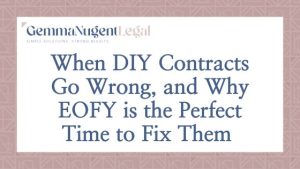How can you prevent scope creep eroding profit? It’s a question that keeps project managers awake at night.
I once worked with an amazing operations manager. When he opened up a commercial contract, he always turned straight to the scope of services or works.”Gemma”, he would say, “legal risk is one thing but the scope is where the rubber hits the road”.
I think about that a lot. It surprises me how often businesses will enter into a contract that says exactly nothing about what they will be doing.
I bet you’ve seen contracts like this. It might be a purchase order or a standard form document. It’ll have a field for “Services” or “Works”. There’s a loose description like “Civil engineering” or “Building construction” or Contract administration”.
Other than that umbrella statement there isn’t a single detail about what the service provider will be doing. And there is nothing else in the contract that either contains or refers to the scope of the services.
So I ask the service provider how they will tackle a disagreement about scope or variations. They say “Look Gemma, it’s fine. These clients are really nice. We’ve had lots of project discussions and there are some emails that explain it all”.
But often there is an “entire agreement” clause that sets aside the emails and telephone conversations. That means the scope of the services is wide open for interpretation. And I wish I had a dollar for every “really nice” client who has knocked back a variation claim… I’d be a lot closer to that beach house.
Poor scoping? Say goodbye to your margin
So what is scope creep? It’s when your client tacks on more and more “incidental” tasks that they “assumed would have been included”. If your scope is loose, it’s difficult to resist those requests.
If your baseline isn’t clear, it may feel like the extra tasks aren’t substantial enough to go through the variation process. But they will add up over time.
Eventually the additional work erodes any chance you had of making a decent margin. Your profit has been eaten up by extra work. Not to mention the administration generated by that work. What happens when you realise the volume of additional tasks (if you ever do)? You’re time barred from making a claim. Or else you can’t satisfy the variation requirements (e.g., you didn’t obtain a written variation instruction prior to commencement).
Having a detailed scope of services is your first line of defence against scope creep.
Setting the baseline sets you up for success
A detailed scope of services or works helps you reach clear agreement with your client about exactly what you will be doing and how much they will be paying for it. It sets the baseline from which you can discuss change.
Your client can ring you up and say “While you’re doing X, I thought you could also include Y – I think it’s relevant and you’ll need to do it anyway”. You’ll be able to point to your scope and politely say that the requested task is a variation and would they mind confirming it in writing.
The 5 elements of an effective scope of services or works
1. Assumptions and required clientinputs
Set out any assumptions that underpin your price. For example, “the proposed design scope assumes that the geotechnical survey provided with the tender documents does not require verification”. Or, “the proposed program assumes that access will be granted to site by 17 June”.
2. Line items for everything
Then I suggest breaking your scope down into as many steps as you possibly can, even if they seem tiny. Include a line item for each with a specific cost applied to it. Construction contractors tend to do this better than engineers for the simple reason that they price on lump sums and for materials as well as labour. Engineers and consultants can take a lesson from this – the more detailed the scope, the more accurate the price is likely to be, so you’re reducing some of the risk of scope creep before you even submit your tender.
3. Include dates of delivery and dates for client input
Set a proposed delivery date for each of the line items (or stages of scope), and the date for any required client inputs. There are plenty of project management software packages in the market that will allow you to populate a project plan with dates that can be updated automatically as the program shifts
4. Include proposed invoicing dates
As well as providing a framework from which you can productively negotiate change, a properly detailed scope gives you an effective structure from which you can invoice for progress against completion. This helps you manage your cash flow, because you can invoice accurately for more of the project monthly. If you’re invoicing on milestones, a detailed scope may help you introduce additional milestones at shorter intervals.
5. Exclusions
To help the scope of services effectively prevent scope creep from eroding profit, you should take special care to specifically exclude things that aren’t in the price but the client might ask for. Explicitly state the kind of tasks that frequently generate variation disputes, and clearly state that such tasks attract additional fees.
Do it the easy way
Here’s a practical tip for making sure your contract includes the scope: ask for your proposal to be incorporated in the contract.
Your proposal should articulate what you propose to do and for how much, in detail. Even if the job you’re doing came about by way of emails or telephone discussions, tell your client that you’ll “draw up a written summary of the conversation for the project file” and then write a proposal the same as you would for a competitive tender.
Assuming that your proposal does describe what you’ll be doing in a reasonable level of detail and your client agrees to it, it’s an easy way of setting that variation baseline. In the field of the PO that previously said “civil engineering”, ask for it to say “civil engineering as set out in Proposal CE210715 dated 15 July 2021”.
Protect your bottom line
Often you’ll find yourself working with a principal who you know to be a repeat offender for throwing extra tasks at you and expecting them to be free.
So how can you save your profit margin from the death of a thousand tiny cuts? Spend some time polishing up your scope of services or works.
Need a second set of eyes to gauge whether it is detailed enough to prevent scope creep from eroding profit? Give me a call, I’d be happy to help.






